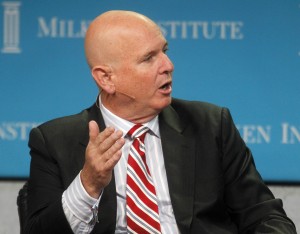
- CalSTRS pays bonuses based on PE performance vs. its benchmark
- Meketa advised State Street benchmark not suited for determining bonuses
- CalSTRS previously changed benchmarks two years ago
California State Teachers’ Retirement System is weighing modifications to its private equity benchmark, according to memos the pension released in advance of its April 5 meeting.
Should the board approve the changes, CalSTRS’s new PE benchmark would customize its existing State Street PE index to reflect the system’s commitment pacing, as well as its allocations to sub-asset classes like secondary funds and co-investments.
CalSTRS’s $16.2 billion PE portfolio was underperforming the existing State Street benchmark on one-year, three-year, five-year and 10-year bases as of Sept. 30, pension documents show. Since inception, the portfolio’s netted a 12.9 percent return, exceeding the State Street benchmark by a little less than 0.5 percentage point.
According to a staff memo signed by Private Equity Director Margot Wirth, staff determined that “significant noise in the performance comparison arises from differences between the composition of the CalSTRS portfolio over time and the benchmark portfolio.”
CalSTRS did not respond to a request for comment.
CalSTRS’s PE benchmark plays a significant role in determining annual bonuses for the retirement system’s investment staff.
Last year, CalSTRS’s PE consultant, Meketa Investment Group, suggested the $202.1 billion retirement system to modify its PE benchmark to take into account its secondary fund, co-investment and special mandate holdings. These strategies have a different return profile than traditional private equity.
The recommendation was connected to CalSTRS’s restructuring of its system for allocating investment staff bonuses, which rewards staff for exceeding asset-class performance benchmarks.
For PE, staff maximizes its bonus eligibility when the portfolio exceeds the current State Street benchmark by 0.7 percentage point. Under the current scheme, CalSTRS’s private equity team would not have been eligible for a performance-related bonus between 2009 and 2014, Meketa wrote in a memo.
“As a result, the [State Street PE index] may be structurally inappropriate as a benchmark for performance compensation,” Meketa wrote. The consulting firm attributed some of the differences between CalSTRS’s performance and that of its benchmark to its co-investment and secondary fund holdings.
The retirement system’s incentive compensation played a role in its decision to adopt the State Street benchmark a little more than two years ago. At the time, CalSTRS benchmarked its PE performance against the performance of the Russell 3000 public index plus 3 percentage points.
The private equity portfolio generated a 19.6 percent return during the 2013-2014 fiscal year, outperforming its overall portfolio by a little less than 1 percentage point. The Russell 3000 plus- three-percentage-point benchmark notched 26.4 percent. As a result, CalSTRS did not reward its staff with any incentive pay for portfolio or total fund performance that year.
“We realize there is a bit of a disconnect between our performance vs. the benchmark we had been using, which was a public benchmark,” spokesman Ricardo Duran told Buyouts at the time. “The benchmark that we were using wasn’t the best.”
Commitments surge to close 2016
Even with prices on new buyout assets near or exceeding records, CalSTRS continues to commit to new PE funds at a healthy clip, a Meketa presentation included in the materials shows.
CalSTRS committed $2.7 billion across 17 funds and four co-investments during the second half of last year, more than double the $1.3 billion it allocated in the first half. The majority of the retirement system’s recent commitments went to buyout funds, with a $316 million allocation to Permira’s sixth flagship fund leading the way.
CalSTRS also committed $300 million to Kohlberg Kravis Roberts & Co’s latest North American fund, which held a final close on $13.9 billion in March.
In an annual investment plan released last year, CalSTRS indicated it would maintain its long-term pacing goals while “remaining mindful of high valuations and high level of dry powder within the [private equity] industry.”
“Past experience has proven many times over that attempting to time private equity markets to any large degree is difficult and probably unwise,” the business plan says. “Past experience also dictates that it is also unwise to be fully swept away by the momentum of rising valuations, shortened fundraising cycles and rapidly increasing fund sizes.”
CalSTRS had a 9 percent allocation to PE as of Sept. 30, according to the Meketa report. Its long-term target allocation to the asset class is 13 percent.
Action Item: Check out the CalSTRS documents here: http://bit.ly/2oFcYF7
Christopher Ailman, chief investment officer of California State Teachers’ Retirement System, speaks during a panel, “Europe at a Crossroads,” at the Milken Institute Global Conference in Beverly Hills, California, on May 2, 2012. Photo courtesy Reuters/Fred Prouser


 If you do not receive this within five minutes, please try and sign in again. If the problem persists, please
email:
If you do not receive this within five minutes, please try and sign in again. If the problem persists, please
email: